Research Fields
From particles to cosmology,
a quest for undiscovered principles of Nature.
The aim of physics is to study various phenomena in Nature. From ancient time, people have been interested in such phenomena in the earth and the sky, and have discovered the mechanisms and the law. However, we still have lots of phenomena that are veiled in mystery. Researchers have devoted themselves day and night to solving such mysteries in Nature. In our physics department, various kinds of researches have been carried out, such as astrophysics and cosmology, -challenging to mysteries in cosmos-, the elementary particles and quantum field theory, -exploring the origin of matter-, and condensed/soft matter physics, -studying the structure and the nature of matter-.
Click on the names of faculties below for more information.
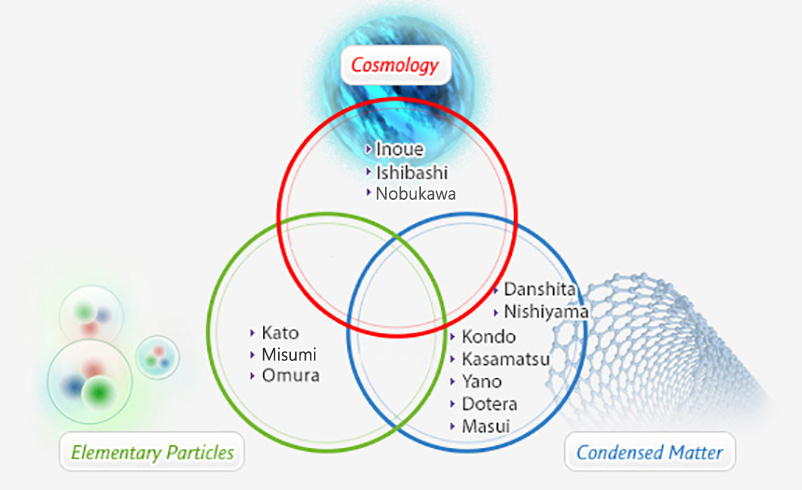
General Relativistic and Cosmology: ISHIBASHI Akihiro [Professor Dr.]
General Relativity and Cosmology
"What was the origin of our universe?" This is perhaps the simplest but one of the most profound questions in physics. And it is related also to other questions such as "Why does our universe look like 4-dimensional?"
Aiming at ultimately addressing such fundamental questions, we have been working in the areas of cosmology and gravitation, concerning especially theoretical aspects of (1) higher dimensional gravity and black holes (2) cosmological dynamics and branes (3) global structure and spacetime singularities, as these play a key role to build bridges between observational cosmology and fundamental theories, such as string theory, that attempt to unify the forces in nature.

Cosmology: INOUE Kaiki Taro [Professor Dr.]
Unraveling the nature of dark matter and dark energy in the universe
Although the dark energy/matter constitute most of energy/matter in the present universe, the nature has been a big mystery. In order to unravel it, I try to determine the fundamental theory of gravity that governs largest-scale structures (superstructures) in the universe. In order to do so, I use data of cosmic microwave background and 3D-distribution of galaxies in the sky. Developing observational tests of the Copernican Principle is another interesting subject. I also investigate distrubution of dark matter on sub-galactic scales (substructures) using QSO-galaxy lensing systems collaborating with astronomers.
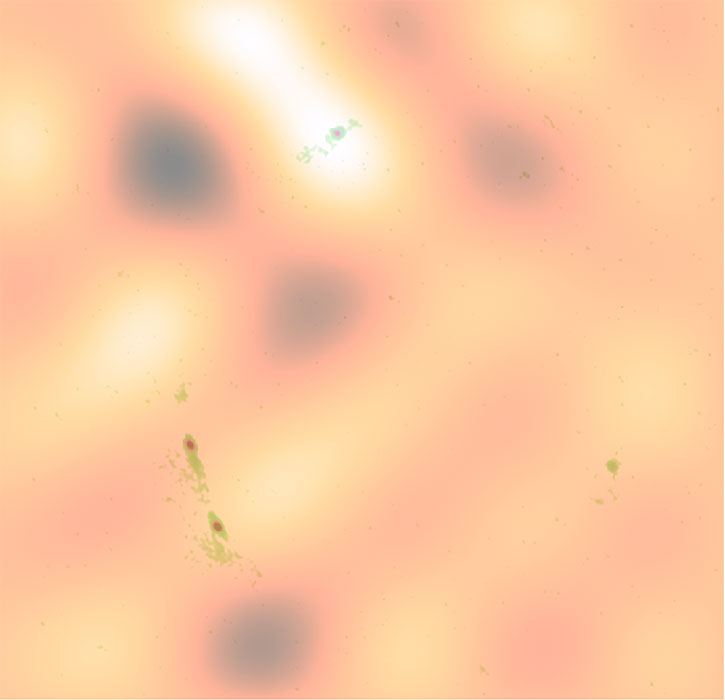
Experimental particle physics: KATO Yukihiro [Professor Dr.]
High energy particle accelerator approaches the origin of the universe.
The universe is born of the high temperature and high density situation, so called Big Bang, and has been inflated with the time passage. How should we research of the birth of the universe? The Collisions of high energy proton and anti-proton, electron and positron using the particle accelerator can make the similar state of the birth of universe during the moment. Observation of the various particles and interactions come from this state can make us predict what happened when the universe was born. Now, we have been developing the detector on International Linear Collider (ILC) project in cooperation with many researchers all over the world.
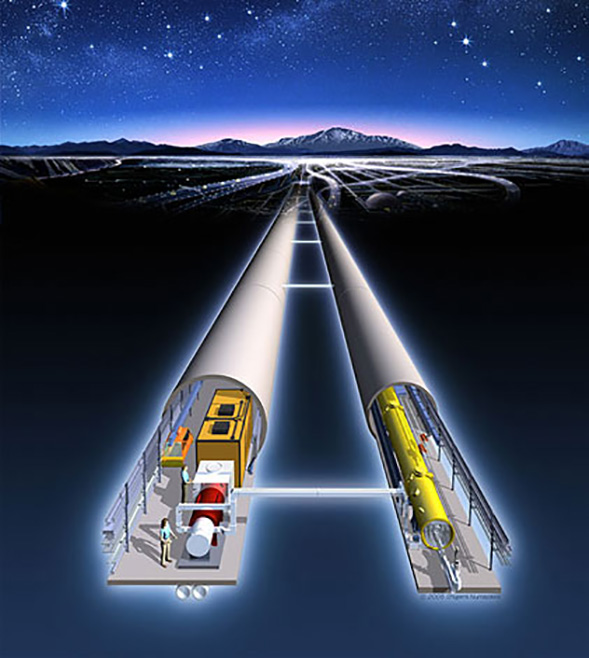
Quantum Control Laboratory: KONDO Yasushi [Professor Dr.]
Controlling of a quantum system
I have been studying superfluid He-3 under rotation, magnetism below 1mK, Si surfaces with SQUID, NMR, STM, and so on at Kyoto University, Low temperature laboratory (Helsinki University of Technology in Finland), Experimental Physik V (Bayreuth University in Germany), and Joint Research Center for Atom Technology - Angstrom-Technology Partnership (dissolved in 2002/3), c/o National Institute for Advanced Interdisciplinary Research in Japan). What I have studied so far were phenomena governed by quantum mechanics. I am now interested in quantum computing, or controlling of a quantum system. I have succeeded to implement several quantum algorithms, such as quantum teleportation without irreversible detection, as shown in the figure I. Recently, I have also started developing an NMR equipment that can be employed for implementing simple quantum algorithms.
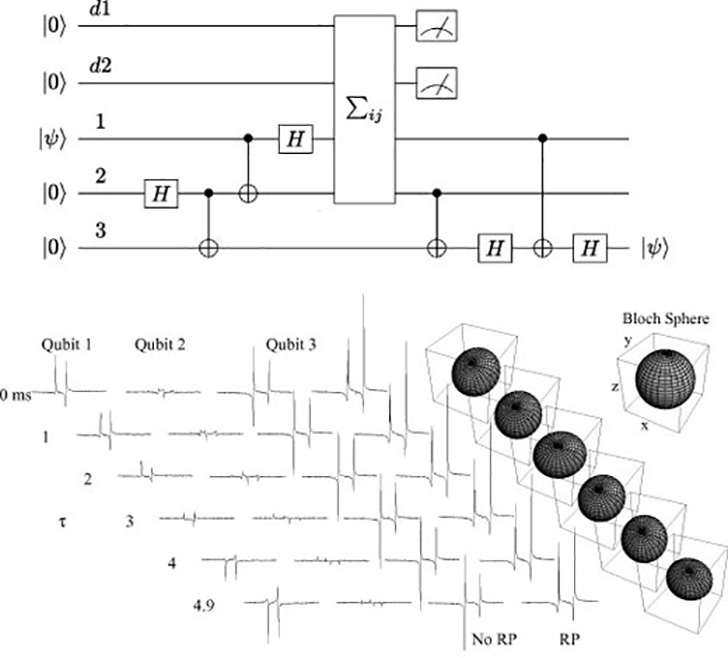
Soft and complex condensed matter physics: DOTERA Tomonari [Professor Dr.]
Beyond fabrics: star-polymers weave a quasiperiodic pattern
Tiling and patterns are known not only to mathematicians and crystallographers, but also to designers and visual artists as the basis of decorative art appearing on furniture, curtains, wall papers, kilts, ceramics, ties, etc. But, nowadays, a cutting-edge art could be self-organized patterning made up of star-polymers designed by scientists. Without fabrication technique, star-polymers can produce elegant self-assembled periodic and quasiperiodic patterns. We have been creating several complex but periodic patterns known as antique Archimedean tiling patterns, and finally, we have shown the evidence of a "polymeric quasicrystals" tiling for the first time.
Quasicrystals are the avant-garde structures that have noncrystallographic symmetry, and initiated a revolution of crystallography and solid-state physics in 1980's. Remarkably, our polymeric dodecagonal quasicrystal has a hundred times length-scale compared to metallic systems, and thus it approaches the scale of visible light, where a promising photonic application has been considered. Our result indicates the universality of quasicrystalline order from atoms to polymers.
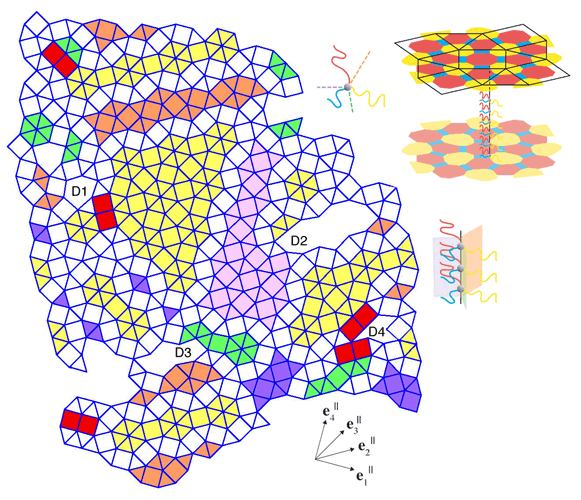
Theory of condensed matter physics: KASAMATSU Kenichi [Professor Dr.]
Theoretical study of ultracold quantum gases and Bose-Einstein condensation
The Bose-Einstein condensation, a new state of matter predicted by Einstein in 1925, is caused by condensation of a macroscopically large number of bosons into a single-particle quantum state below a Bose-Einstein transition temperature. A remarkable consequence caused by the condensation is an expansion of microscopic quantum phenomena into macroscopic scales.
This is an essential origin of superfluidity and superconductivity, in which macroscopically extended phase coherence allows the dissipationless current to flow. Ultracold atoms at nK temperature are simple and controllable systems to address fundamental questions of quantum mechanics and quantum many-body physics, e.g. quantum phase transitions, superfluidity, and efficient quantum information processing, etc. Our current research is to understand theoretically the structure, stability and dynamics of Bose-Einstein Condensates (BECs) of ultracold atomic gases in confining potentials.
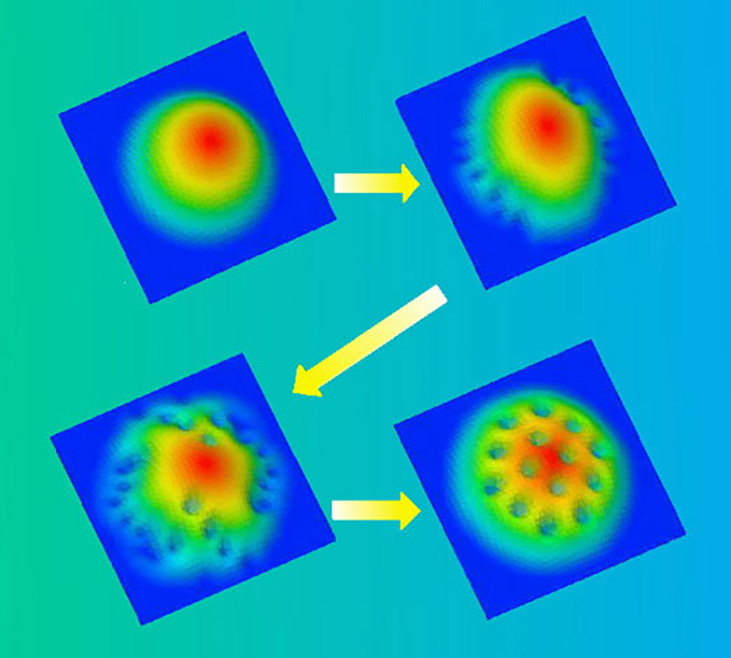
Quantum Many-Body Physics Laboratory: DANSHITA Ippei [Associate professor Dr.]
Development of theoretical and numerical methods for quantum many-body systems and their applications to condensed matter
In condensed matter systems, such as electrons in solids and liquid helium, quantum nature of constituent particles often emerges at macroscopic scales. There competitions and/or collaborations of the quantumness and the interparticle interactions lead to various interesting phenomena, including superfluidity, superconductivity, quantum phase transitions, and many-body localization. We develop theoretical methods describing quantum many-body systems, aiming to understand those phenomena more deeply and to discover novel quantum many-body effects. We also support experimental development of analog quantum simulators using ultracold gases in optical lattices from a theoretical viewpoint.
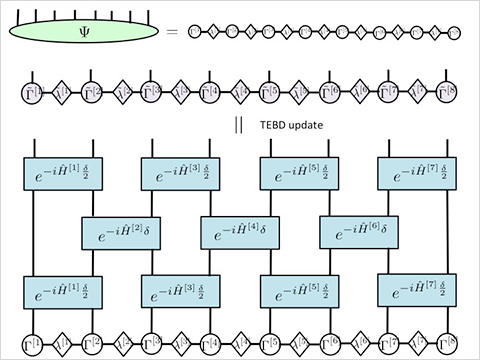
Laboratory for Dynamic Living Systems: NISHIYAMA Masayoshi [Associate professor Dr.]
Elucidating the mechanism of biological molecular machines.
Biomolecules are nanometer-sized molecular machines, which collaborate well in conjunction with water molecules. We are seeking to develop a new analytical method to modify molecular structures and functions by utilizing high-pressure techniques and performing microscopic analyses with extremely high resolutions. The developed system could allow us to control molecular machines without the use of any chemical materials other than water molecules within those cells. Our research goal is to elucidate the operating principle how biological molecular machines work efficiently in collaboration with water molecules.
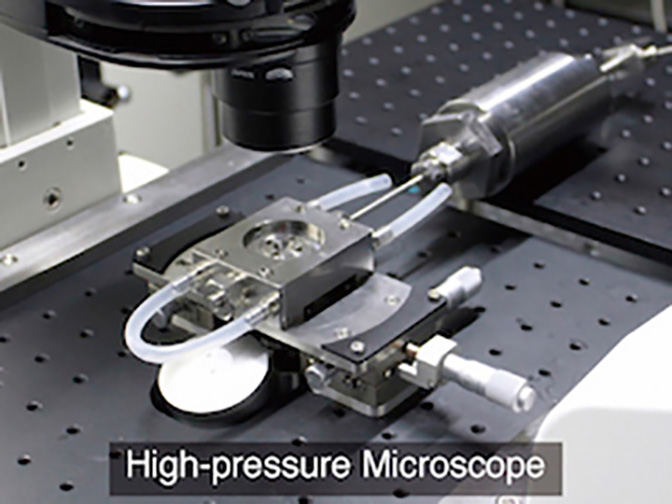
Solid State Physics Laboratory: MASUI Takahiko [Associate professor Dr.]
Experimental study of Superconductivity and Magnetism
In our laboratory, the targets of the study are exotic properties in solids, such as superconductivity in cuprates, magnetism with frustrated structure. We are interested in contribution of electron-phonon interaction and pseudogap phenomenon in high temperature superconductivity.
In the research various experimental methods are used, such as crystal growth in a furnace, measurements of transport and optical properties.
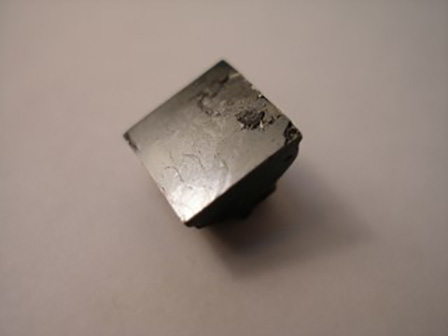
High Energy Theory: MISUMI Tatsuhiro [Associate professor Dr.]
The most elementary objects in nature, called "elementary particles", are described by the theory named as "quantum field theory". Quantum theory describes microscopic phenomena, where positions or speeds of particles are uncertain in general. In quantum field theory, the existence of particles is itself uncertain and the particles can emerge from the vacuum and can disappear too. In our Lab., we investigate the ways of analyzing quantum field theory and apply them to realistic phenomena in order to obtain deeper understanding of the nature. In particular, we attempt to understand "quark confinement" and "mass gap generation" which result in the formation of protons and neutrons by use of mathematical and computational methods.
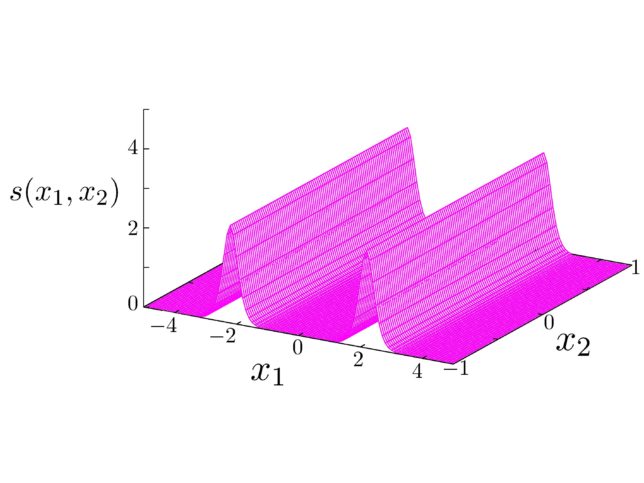
Bion configuration in quantum field theory
Biophysics Laboratory: YANO Yohko F. [professor Dr.]
Towards understanding life phenomena at the atomic level
Our lab is interested in the structural biophysics of proteins especially at interfaces. Since proteins fold their hydrophobic regions within hydrophilic regions in water, conformational changes are expected when they adsorb at water interfaces. One approach towards understanding the mechanisms of protein folding is to study the procedures and conditions that lead to protein unfolding.
X-ray reflectivity technique is a powerful tool for exploring surface phenomena.We are developing an x-ray liquid interface reflection system at SPring-8 to investigate the protein unfolding at interfaces.
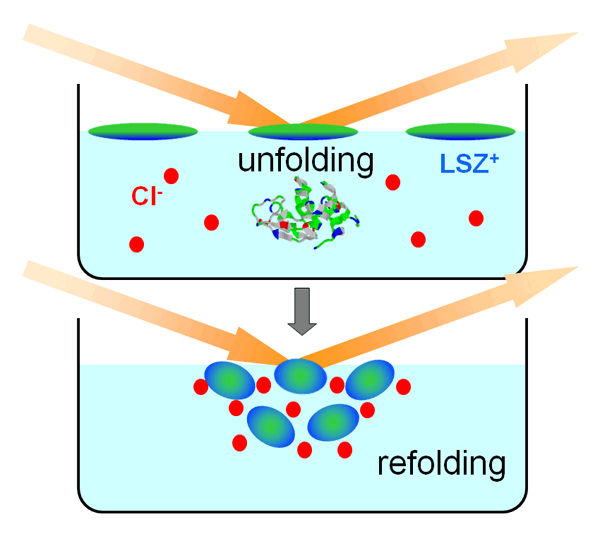
Theoretical Particle Physics: OMURA Yuji [Associate professor Dr.]
Exploring new physics beyond the Standard Model
In our universe, there are a lot of mysteries concerned with elementary particles. For instance, we do not know the origin of the electroweak scale and why there are three generations in quark and lepton sectors. Besides, dark matter may be a new elementary particle. In this laboratory, we study a lot of new physics possibilities motivated by mysteries in our universe and discuss which models are realistic to explain the latest experimental results. From phenomenological point of view, we explore for unknown physics beyond the Standard Model of elementary particle.
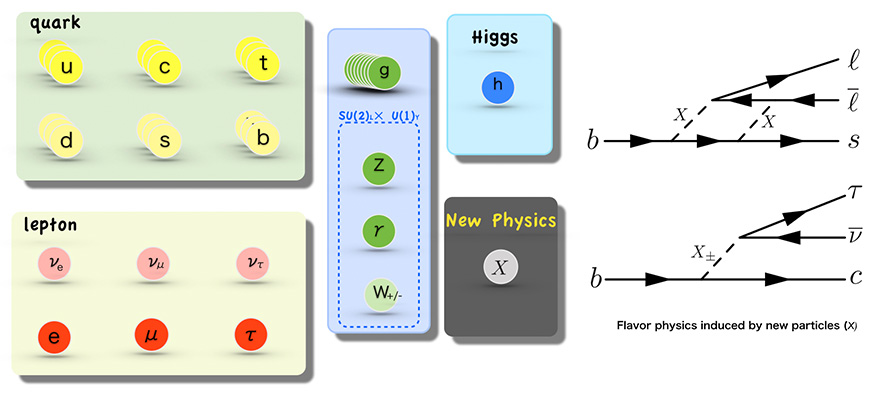
The list of elementary particles and a new physics possibility (X)
X-ray Astronomy: NOBUKAWA Kumiko [Lecturer]
X-ray observations have revealed that the universe is hot and energetic. My research focuses on low-energy cosmic-ray measurements through X-ray observations with the aim of clarifying the origin of cosmic rays and the effects of cosmic rays on our galaxy. In addition, I have studied various high-energy phenomena that occur in the interstellar space. As a project member of the XRISM X-ray astronomy satellite scheduled to be launched in the early 2020s, I am also developing the X-ray CCDs onboard the satellite. I also plan to develop a new X-ray detector for future X-ray astronomy satellites.
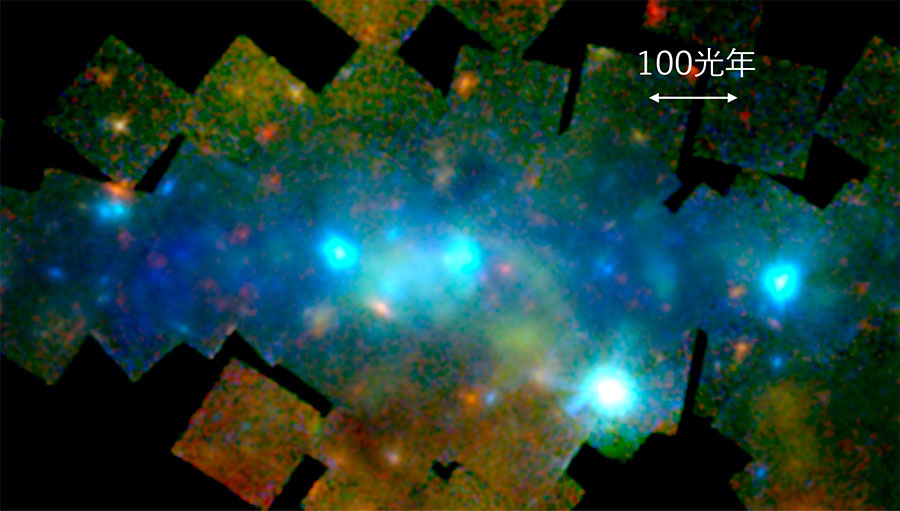
X-ray view of the central region of our galaxy